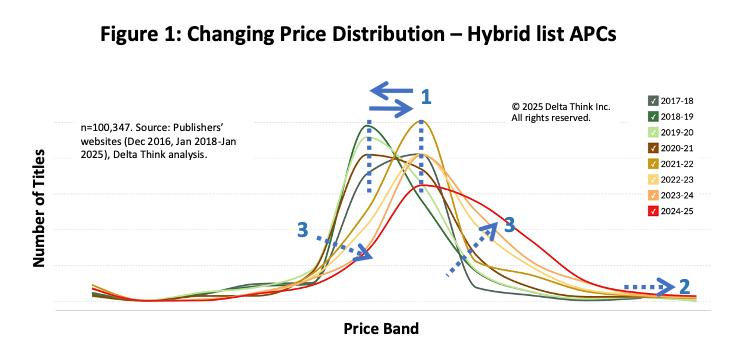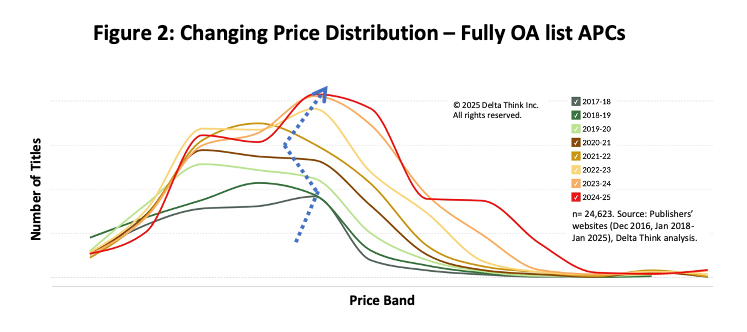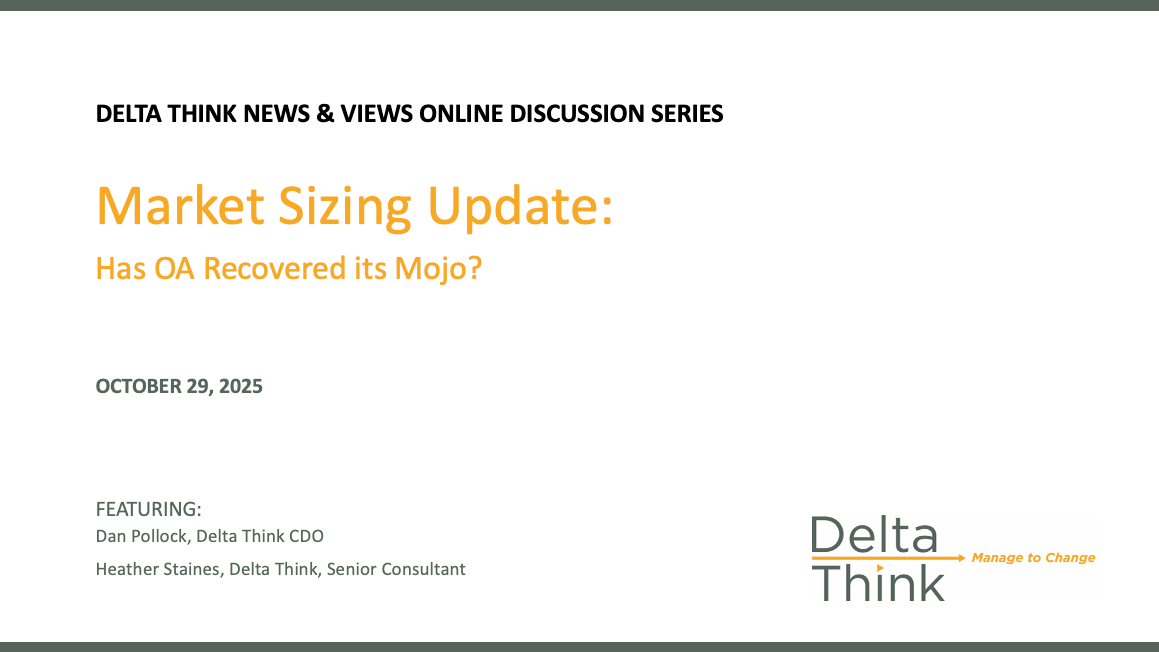News & Views: Open Access Charges – Price Increases Back on Trend

This month we look at our latest data about Article Processing Charges (APCs). Per article pricing is a fundamental building block for all paid publishing models, so our review provides an invaluable insight into how costs of open access continue to evolve. APC prices in general continue to increase, but at a slower rate compared with this time last year. Important nuances in the distribution of prices continue to affect the value and cost of paid publishing models.
Background
Each year we survey the list Article Processing Charges (APCs) of a sample of major and significant publishers. Covering more than 20,000 titles going back to 2016, our dataset represents one of the most comprehensive reviews of open access pricing.
To compare like for like, we consistently analyze non-discounted, CC BY charges. We take a snapshot at the end of every January, so we can track yearly changes while controlling for the different times of year that publishers may update prices. Our statistics exclude zero or unspecified APCs, although these are included in our underlying data. This allows us to understand trends where publishers choose to charge APCs without skewing averages. We run separate analyses around APC-free models.
Headline Changes
Going into 2025, we have seen APC pricing increasing but falling back to long-term trends.
- Fully OA APC list prices across our sample have risen by around 6.5% compared with 9.5% this time last year.
- Hybrid APC list prices have risen by an average of 3% compared with 4.2% this time last year.
- Maximum APCs for fully OA journals remain at $8,900.
- Maximum APCs for hybrid journals now top out at $12,690 (up $400 from last year).
- Big jumps in prices happened last year, driven by high inflation. In 2020-2021 prices were driven up when high-impact journals began offering OA options for the first time. In both cases, increases subsequently fell back to averages.
Underlying trends continue.
- There are around 2.6x more hybrid journals than fully OA ones, down from 2.9x a year ago. Hybrid journals follow (or, rather, set) a similar pattern to the market overall.
- On average, fully OA prices are around 64% of those of hybrids. This is a couple of percentage points higher than long term trends.
- Around 31% of our sample of fully OA journals charge no APCs. (We have separately analyzed the number of articles in OA journals.)
- Price rises vary significantly by discipline. Arts & Humanities and Social Sciences have seen particularly large average increases, especially in fully OA journal prices.
Price Distribution
Market-wide headline price changes mask important nuances. We have discussed previously that the most important nuance lies in the spread of prices within a given publisher’s portfolio. For example, if the bulk of a publisher’s journals lie toward the lower end of its pricing, with just a few journals priced at the high end, the average (mean) price will be higher than most authors pay.
The following figures show how the spread of prices plays out in the market across our sample of publishers. The figures are outlines of histograms, showing how many titles sit in various price bands over the successive years of data we have curated. The red line shows the most recent year’s prices. The lines become greener as they go further back in time. Subscribers to Delta Think’s Data and Analytics Tool can see full details of axes.
Hybrid Prices
The spread of price bands for hybrid journals is shown in Figure 1 below.

The overall spread of prices has remained relatively constant over time.
- In 2019-20, the most popular price band shifted slightly towards the lower end of the market and remained there for a few years. However, in 2021-22 it moved back up to its historic high and has remained there since.
- The steepest prices increases occurred in 2020-21, when high-impact journals began offering hybrid options. For clarity, the chart combines the very highest APCs into one band on the right-hand side.
- Average prices paid are heavily influenced by the shape of the curves on either side of the peak. Notice how the curve on the right side of the peak is becoming shallower and wider over time. This suggests that increasing numbers of journals are priced higher than average, and so average prices paid will increase. The curve to the left of the peak was getting shallower, but it is now getting steeper. So, the moderating influence of lower-priced journals is now reducing. As the curve widens, the peak reduces to keep the area under the curve roughly the same. This reflects the relatively small change in the total number of journals compared with previous years. We are therefore seeing a movement in price bands of existing journals to increase average prices paid, as higher APCs are becoming more prevalent.
Fully OA Prices
The fully OA landscape is shown in Figure 2 below.

The data suggest that both the number of fully OA journals and their average APC prices continue to increase.
- The peak of the curve is getting higher and moving to the right, so we are seeing an increase in the most popular price band and in average prices.
- In earlier years, the secondary peak suggested the presence of a significant number of journals cheaper than the most popular price band, which moderated the increase in average prices.
- In more recent years, the secondary peak moved to the right as prices increased, and more expensive journals became more common.
- However, as with hybrids, the right-hand side of the curve is becoming shallower. The increasing number of more expensive journals will increase average prices paid. The flattening of the curve on the right-hand side is likely a coincidence as the market continues to evolve. This is likely due to a mix of some hybrid journals moving to fully OA and taking their higher prices with them, and simply by chance that some fully OA price increases have moved into a slightly higher band. Next year, we may see this smooth out, or we may be seeing the emergence of third peak in the chart.
- The height of the curve has also increased at the same time, illustrating that we are seeing an increase in total number of fully OA journals. This is due to a mix of more journals being launched or acquired, and hybrid journals being switched to fully OA.
Conclusion
Last year we noted that inflation drove above-average price increases. Going into 2025, as inflation has come down, increases have fallen back towards long-term trends.
While outlying price changes are important general indicators, they do not necessarily shift the market on their own. Changes in the spread and emphasis of popular price bands play key roles too. The increasing proportion of higher-priced journals continues to increase the average prices actually paid.
As we explored at length in our analysis “APC Price Changes – When does up mean down?”, average headline price increases can lead to falling overall spend or vice versa, depending on the numbers of papers published and the spread of price increases across a portfolio.
One moderating influence is the high number of journals – usually fully OA titles – that don’t charge APCs. We have not analyzed these here, as we want to focus on patterns in APCs actually charged. Fully OA journals that do not charge APCs are typically funded by some other means.
Per-APC information is useful in a wider context too. Even where deals are calculated based on bundles, they are often set by discounting from list APCs – especially where publication activity exceeds agreed caps. The high number of journals with no APCs will most likely have their sponsorship prices set based on per-paper revenues desired. Similarly, understanding revenues generated per paper is important to calculate thresholds for journal flips or for launching and sustaining a Subscribe to Open model.
Studying individual journal list APCs remains foundational for understanding pricing across all OA business models. Here we have covered average prices across the market. The averages can vary based on discipline. If you are curious how your APC pricing compares to the market, please contact us for a customized review.
---
This article is © 2025 Delta Think, Inc. It is published under a Creative Commons Attribution-NonCommercial 4.0 International License. Please do get in touch if you want to use it in other contexts – we’re usually pretty accommodating.
---
TOP HEADLINES
Open Monograph Press (OMP) Review In Progress – March 5, 2025
"The Public Knowledge Project (PKP) is investing in the future of open book publishing by undertaking a review of Open Monograph Press (OMP)...As part of Open Book Futures (OBF), and with our recent move to join the Open Book Collective (OBC) Supporter Program, we are committed to ensuring that our path forward is grounded in the community’s needs and reflects the evolution of the open book ecosystem over the years since OMP launched in 2013."
UPLOpen expands open access library to 10,000 titles supporting global research – February 24, 2025
"UPLOpen, the open-access eBook platform managed by the De Gruyter eBound Foundation, has reached a milestone of 10,000 open access titles from more than 50 academic publishers...Since its launch in April 2024, the platform has expanded its collection with works from more than 50 academic publishers, focusing on making scholarly research widely accessible."
EIFL OA publishing agreements cover 2,927 journals – February 17, 2025
"We have updated the lists of journals in which corresponding authors from our partner countries can publish in open access for free or at discounted Article Processing Charges (APCs)...We start 2025 with agreements with 15 publishers allowing authors from EIFL partner countries to publish in open access at waived or discounted APCs in 2,927 journals (379 more journals than in 2024), across a wide array of disciplines."
OA JOURNAL LAUNCHES
Biochemical Society journals S2O decision 2025 - March 3, 2025
"Five leading journals published by the Biochemical Society, by and for molecular bioscientists, will be published open access (OA) during 2025."
Subscribe to Open threshold met: Journal of General Virology and Journal of Medical Microbiology now Open Access - February 14, 2025
"The Microbiology Society is pleased to announce that, thanks to the support of subscribing institutions, we have successfully met our sustainability target for the Journal of General Virology and the Journal of Medical Microbiology under the Subscribe to Open (S2O) model for 2025."







News & Views: Will cuts to National Science Foundation funding affect scholarly publishing activity?






